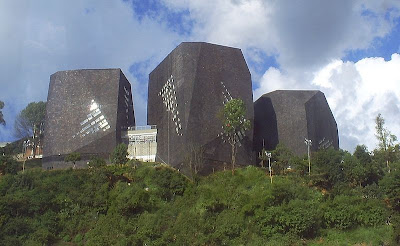Director Paola Perez will present a free screening of her new documentary "Pablo Is Gone" in Medellin's Santo Domingo barrio.
The film was produced with the help of many of the local children who live in some of poorest areas in Medellin where the movie was made.
Event: Special Screening of "Pablo Is Gone."
Date: May 14
Time: 10:00 am
Where: Santo Domingo Savio - Auditorio Parque Biblioteca Espana
Contact: 385 75 99
"Pablo Is Gone" official trailer
Wednesday, May 12, 2010
Sunday, May 9, 2010
Medellín's Architectural Renaissance
Young designers, encouraged by forward-thinking leaders, have created notable works in some of the city's poorest areas.
By Christopher Hawthorne, Los Angeles Times Architecture Critic

Over the last two or three years, a steady buzz has been building in architecture and design circles about developments in this city of 3.5 million, which through much of the 1980s and 1990s was infamous for its sky-high crime rate and viciously competitive narco cartels, including a particularly violent one led by Pablo Escobar.
Architects and urban planners who traveled to Medellín seemed to return telling some version of the same enthusiastic story about the renaissance taking place in Colombia's second-largest city, which has been driven in large part by investment in ambitious civic architecture.
After spending nearly a week in the city in late March, I'm happy to say I've joined the ranks of the Medellín evangelists. The city's commitment to public architecture, spearheaded by former mayor Sergio Fajardo, has — as advertised — produced a number of exquisitely designed libraries, schools and parks. Rising in some of Medellín's roughest neighborhoods, these projects are the capstones of a broader civic rebirth that has seen murder rates tumble nearly 90% from their highs of the early 1990s. Even the tourism business here has begun to make a fragile recovery.
It quickly became clear during my visit what contemporary architecture has meant for Medellín — for its civic identity, in particular, as well as for its long-battered international reputation. And yet the more of the city I was able to see, the more it struck me that an equally important set of lessons might be found by reversing that equation, by exploring what Medellín and its revival mean for contemporary architecture.
The architecture profession finds itself sharply divided these days into two camps, one concerned with experimental, often digitally driven design and the other primarily committed to social and environmental activism. The high-design architects sniff that the humanitarians are terrible designers, or at least unimaginative ones, while the humanitarians complain that the high-design architects are trapped in a hermetic onscreen world with little concern for the fate of overcrowded slums or a degraded planet.
Medellín is one of the few cities where these two very different sets of priorities have come seamlessly together — where buildings meant to uplift poor neighborhoods and offer residents a new range of social services are also strikingly inventive as works of architecture. In that sense its hard-won improvements are meaningful not just for its own residents but for architects and planners elsewhere, even if they never have the chance to set foot in Medellín.
The city's revival has its roots in the unorthodox approach of Fajardo, an energetic, charismatic former math professor who was elected mayor in 2003 despite a thin political resume. Not long after taking office, he and Alejandro Echeverri, the mayor's director of urban projects and an architect in his own right, pinpointed several districts in Medellín they thought would benefit from inventive and public-minded architecture. They were inspired, they've since said, by the way certain Barcelona neighborhoods were revived in advance of the 1992 Summer Olympics, as well some positive examples from Brazilian cities.
Their nascent efforts were aided by anti-corruption laws passed at the national level by the government of President Alvaro Uribe, including provisions requiring design competitions for nearly all sizable new public buildings.
Because the budgets for city projects in Medellín tend to be quite low by international standards, these competitions have drawn mostly Colombian architects, along with a handful from nearby Latin American countries. That fact alone is responsible for one of most unusual elements of the Medellín renaissance: In an age of globe-trotting celebrity architects, it has been propelled almost entirely by local firms. The city's new image has been sketched not by Zaha Hadid or Richard Meier but by small offices based in Medellín or the Colombian capital, Bogotá.
Under Fajardo's successor as mayor, Alonso Salazar, the city has continued to produce ambitious new architecture, including extensive new facilities for the South American Games, which were held in Medellín in March. A notable number of recent design-competition winners have been firms run by young architects; the impressive swimming complex for the Games, for example, was designed by a firm called Paisajes Emergentes, or Emerging Landscapes, whose founders are still in their 20s. Ctrl G, a local firm that in conjunction with Peruvian office 51-1 Architects recently won a competition for an eye-catching addition to the Medellín Museum of Modern Art, is run by a pair of female architects, Viviana Peña and Catalina Patiño, who also have yet to turn 30.
Perhaps most striking of all, Medellín's new landmarks have largely been built in the city's most violent and downtrodden neighborhoods, reflecting one of Fajardo's simplest — and most provocative — policy goals.
"Our most beautiful buildings," he liked to say, "must be in our poorest areas."

The best known among those projects is probably the Parque Biblioteca España, or Spanish Park and Library. Designed by the Bogotá-based architect Giancarlo Mazzanti, it is perched atop a crowded hillside neighborhood called Santo Domingo, which was particularly hard hit by the violence of the 1980s and '90s. Made up of three chiseled, rock-like forms sheathed in black slate, the library is one of a half-dozen complexes initiated by Fajardo's administration that combine new libraries with substantial park space.
Another remarkable achievement is the open-air Orquideorama, or orchid center, which sits inside Medellín's Botanical Garden and was designed by Plan B Architects, which is led by 34-year-old architect Felipe Mesa, and the firm JPRCR. It creates a large, shaded plaza under a spreading, wood-lattice canopy and also includes a handful of small, spare buildings for the botanical garden staff. Rainwater collected atop the canopy is funneled down through each of the design's trunk-like forms to sustain small gardens on the ground.
Plan B also won a competition for the centerpiece of the South American Games, a connected series of gymnasiums beneath a roof made of undulating green panels.
These new landmarks are not isolated works of architecture. In many cases they were built in conjunction with new roads, schools and transit lines — and as a physical extension of social programs meant to draw families once terrified by violence in their neighborhoods back out into public life. Fajardo — who is now running for the vice-presidency of Colombia, with national voting set for May 30 — has called the approach "social urbanism."
Some of the poorest and most remote areas in Medellín, where public buses have trouble navigating narrow dirt streets, are now served by a pair of so-called metro-cable lines — essentially, an urban version of the gondola systems in operation at many ski resorts — that carry residents to and from the city's main light-rail line. It is incongruous, to say the least, to see the metro-cable's suspended gondolas, which we tend to associate with alpine scenes and high-priced lift tickets, gliding just a few feet over the handmade houses that cling to many of Medellín's steepest hillsides.
Medellín's new architecture has hardly been a cure-all. The poverty in the city's toughest neighborhoods remains extreme, and in recent months there has been a disturbing uptick in violence — so much so that some of the Medellín architects I met expressed concern about taking me to visit their projects in rougher areas, even during the day.
Still, by nearly all accounts, the libraries and other new public buildings remain popular and well-used by local residents. And for designers, critics and curators outside of Colombia, the Medellín story — and what that story says in a larger sense about shifting priorities in the architecture profession — continues to be an inspiration. Fajardo and Echeverri were winners last year of the Curry Stone Design Prize, a new award based at the University of Kentucky that seeks to recognize architects and policymakers "who harness their ingenuity and craft for social good."
When the National Design Triennial opens later this week at the Cooper-Hewitt National Design Museum in New York, it will include a pair of projects from Medellín: Plan B's Orquideorama and a science museum designed by Echeverri. The designs were selected for the exhibition by Matilda McQuaid, Cooper-Hewitt's deputy curatorial director, who traveled to Colombia last year. Medellín, she told me, "is a model of how a city can be transformed when architecture and social policy work in tandem."
In October, the Museum of Modern Art in New York will open an ambitious exhibition on similar themes called "Small Scale, Big Change: New Architectures of Social Engagement," which collects a number of recent examples of humanitarian design from around the world.
Medellín, in the end, is more than an isolated urban success story or an example of a city that has managed to bridge contemporary architecture's great divide. It also offers a timely model for Los Angeles and other cities that have long turned almost exclusively to New York and Europe for ideas about how architecture ought to look — and how cities ought to operate.
Just as Gustavo Dudamel, the 29-year-old Venezuelan conductor, has brought fresh energy and a new sense of social commitment to the Los Angeles Philharmonic, so Medellín and other successful examples of Latin American city-making have a role to play in helping Los Angeles reimagine its future.
For American cities and their leaders, what Medellín symbolizes most clearly of all is what we stand to gain by looking south as well as east — and to poor countries, when it makes sense, along with wealthy ones — for cultural inspiration.
christopher.hawthorne@latimes.com
By Christopher Hawthorne, Los Angeles Times Architecture Critic

Over the last two or three years, a steady buzz has been building in architecture and design circles about developments in this city of 3.5 million, which through much of the 1980s and 1990s was infamous for its sky-high crime rate and viciously competitive narco cartels, including a particularly violent one led by Pablo Escobar.
Architects and urban planners who traveled to Medellín seemed to return telling some version of the same enthusiastic story about the renaissance taking place in Colombia's second-largest city, which has been driven in large part by investment in ambitious civic architecture.
After spending nearly a week in the city in late March, I'm happy to say I've joined the ranks of the Medellín evangelists. The city's commitment to public architecture, spearheaded by former mayor Sergio Fajardo, has — as advertised — produced a number of exquisitely designed libraries, schools and parks. Rising in some of Medellín's roughest neighborhoods, these projects are the capstones of a broader civic rebirth that has seen murder rates tumble nearly 90% from their highs of the early 1990s. Even the tourism business here has begun to make a fragile recovery.
It quickly became clear during my visit what contemporary architecture has meant for Medellín — for its civic identity, in particular, as well as for its long-battered international reputation. And yet the more of the city I was able to see, the more it struck me that an equally important set of lessons might be found by reversing that equation, by exploring what Medellín and its revival mean for contemporary architecture.
The architecture profession finds itself sharply divided these days into two camps, one concerned with experimental, often digitally driven design and the other primarily committed to social and environmental activism. The high-design architects sniff that the humanitarians are terrible designers, or at least unimaginative ones, while the humanitarians complain that the high-design architects are trapped in a hermetic onscreen world with little concern for the fate of overcrowded slums or a degraded planet.
Medellín is one of the few cities where these two very different sets of priorities have come seamlessly together — where buildings meant to uplift poor neighborhoods and offer residents a new range of social services are also strikingly inventive as works of architecture. In that sense its hard-won improvements are meaningful not just for its own residents but for architects and planners elsewhere, even if they never have the chance to set foot in Medellín.
The city's revival has its roots in the unorthodox approach of Fajardo, an energetic, charismatic former math professor who was elected mayor in 2003 despite a thin political resume. Not long after taking office, he and Alejandro Echeverri, the mayor's director of urban projects and an architect in his own right, pinpointed several districts in Medellín they thought would benefit from inventive and public-minded architecture. They were inspired, they've since said, by the way certain Barcelona neighborhoods were revived in advance of the 1992 Summer Olympics, as well some positive examples from Brazilian cities.
Their nascent efforts were aided by anti-corruption laws passed at the national level by the government of President Alvaro Uribe, including provisions requiring design competitions for nearly all sizable new public buildings.
Because the budgets for city projects in Medellín tend to be quite low by international standards, these competitions have drawn mostly Colombian architects, along with a handful from nearby Latin American countries. That fact alone is responsible for one of most unusual elements of the Medellín renaissance: In an age of globe-trotting celebrity architects, it has been propelled almost entirely by local firms. The city's new image has been sketched not by Zaha Hadid or Richard Meier but by small offices based in Medellín or the Colombian capital, Bogotá.
Under Fajardo's successor as mayor, Alonso Salazar, the city has continued to produce ambitious new architecture, including extensive new facilities for the South American Games, which were held in Medellín in March. A notable number of recent design-competition winners have been firms run by young architects; the impressive swimming complex for the Games, for example, was designed by a firm called Paisajes Emergentes, or Emerging Landscapes, whose founders are still in their 20s. Ctrl G, a local firm that in conjunction with Peruvian office 51-1 Architects recently won a competition for an eye-catching addition to the Medellín Museum of Modern Art, is run by a pair of female architects, Viviana Peña and Catalina Patiño, who also have yet to turn 30.
Perhaps most striking of all, Medellín's new landmarks have largely been built in the city's most violent and downtrodden neighborhoods, reflecting one of Fajardo's simplest — and most provocative — policy goals.
"Our most beautiful buildings," he liked to say, "must be in our poorest areas."
The best known among those projects is probably the Parque Biblioteca España, or Spanish Park and Library. Designed by the Bogotá-based architect Giancarlo Mazzanti, it is perched atop a crowded hillside neighborhood called Santo Domingo, which was particularly hard hit by the violence of the 1980s and '90s. Made up of three chiseled, rock-like forms sheathed in black slate, the library is one of a half-dozen complexes initiated by Fajardo's administration that combine new libraries with substantial park space.
Another remarkable achievement is the open-air Orquideorama, or orchid center, which sits inside Medellín's Botanical Garden and was designed by Plan B Architects, which is led by 34-year-old architect Felipe Mesa, and the firm JPRCR. It creates a large, shaded plaza under a spreading, wood-lattice canopy and also includes a handful of small, spare buildings for the botanical garden staff. Rainwater collected atop the canopy is funneled down through each of the design's trunk-like forms to sustain small gardens on the ground.
Plan B also won a competition for the centerpiece of the South American Games, a connected series of gymnasiums beneath a roof made of undulating green panels.
These new landmarks are not isolated works of architecture. In many cases they were built in conjunction with new roads, schools and transit lines — and as a physical extension of social programs meant to draw families once terrified by violence in their neighborhoods back out into public life. Fajardo — who is now running for the vice-presidency of Colombia, with national voting set for May 30 — has called the approach "social urbanism."
Some of the poorest and most remote areas in Medellín, where public buses have trouble navigating narrow dirt streets, are now served by a pair of so-called metro-cable lines — essentially, an urban version of the gondola systems in operation at many ski resorts — that carry residents to and from the city's main light-rail line. It is incongruous, to say the least, to see the metro-cable's suspended gondolas, which we tend to associate with alpine scenes and high-priced lift tickets, gliding just a few feet over the handmade houses that cling to many of Medellín's steepest hillsides.
Medellín's new architecture has hardly been a cure-all. The poverty in the city's toughest neighborhoods remains extreme, and in recent months there has been a disturbing uptick in violence — so much so that some of the Medellín architects I met expressed concern about taking me to visit their projects in rougher areas, even during the day.
Still, by nearly all accounts, the libraries and other new public buildings remain popular and well-used by local residents. And for designers, critics and curators outside of Colombia, the Medellín story — and what that story says in a larger sense about shifting priorities in the architecture profession — continues to be an inspiration. Fajardo and Echeverri were winners last year of the Curry Stone Design Prize, a new award based at the University of Kentucky that seeks to recognize architects and policymakers "who harness their ingenuity and craft for social good."
When the National Design Triennial opens later this week at the Cooper-Hewitt National Design Museum in New York, it will include a pair of projects from Medellín: Plan B's Orquideorama and a science museum designed by Echeverri. The designs were selected for the exhibition by Matilda McQuaid, Cooper-Hewitt's deputy curatorial director, who traveled to Colombia last year. Medellín, she told me, "is a model of how a city can be transformed when architecture and social policy work in tandem."
In October, the Museum of Modern Art in New York will open an ambitious exhibition on similar themes called "Small Scale, Big Change: New Architectures of Social Engagement," which collects a number of recent examples of humanitarian design from around the world.
Medellín, in the end, is more than an isolated urban success story or an example of a city that has managed to bridge contemporary architecture's great divide. It also offers a timely model for Los Angeles and other cities that have long turned almost exclusively to New York and Europe for ideas about how architecture ought to look — and how cities ought to operate.
Just as Gustavo Dudamel, the 29-year-old Venezuelan conductor, has brought fresh energy and a new sense of social commitment to the Los Angeles Philharmonic, so Medellín and other successful examples of Latin American city-making have a role to play in helping Los Angeles reimagine its future.
For American cities and their leaders, what Medellín symbolizes most clearly of all is what we stand to gain by looking south as well as east — and to poor countries, when it makes sense, along with wealthy ones — for cultural inspiration.
christopher.hawthorne@latimes.com
Sunday, May 2, 2010
Medellin Trip Report

Medellin Colombia — After I win the Powerball drawing tonight, I think I might just pack up my belongings and move to Medellin Colombia.
Though the city was being labelled as "the most dangerous place on Earth" just a mere 8 years ago, it's a totally different place today. Thanks to VERY aggressive action by the Colombian government against FARC rebels, narcotrafficking crime organizations, and various paramilitary splinter groups, Colombia has become a FAR safer place for its citizens and for visiting foreigners. Nowhere is that change more apparent than in Medellin.
Today, Medellin life is as tranquil as any good-sized city of 2.5 million inhabitants anywhere else in the world. The arts community is surprisingly strong and there's wonderful nightlife with live music clubs, experimental theatre groups in the city center, large glitzy modern shopping malls for the consumers of the world, and a remarkably clean, modern, quiet Metro system that makes getting around easy and affordable.
Medellin does something with their Metro system that I've never seen done anywhere else in the world --- they incorporate cable cars into the mass transit network. This makes sense, given that the city lies in a valley, with rugged mountain peaks on all side (and with communities up in the hills, and on other sides of the mountains). They call the cable car system "Metrocable" and the cable cars connect seemlessly to the Metro trains (no extra cost either). Metrocable is great for the locals, but tourists love it too because you get wonderful views from up on the cables, plus its one of those things you just can't do anyplace else.
I highly recommend taking a good half day to fully explore the excellent Museo de Antioquia. It's an art museum, and a darn good one, focusing on Medellin's favorite local artist: Fernando Botero. I just LOVE Botero's works because he's got an apparent innocence to his style that belies his ability to cut deeply to the core themes that make human beings human. He's sometimes dismissed as "that artist who paints fat people", but his focus on using fat people helps him avoid the insignificant attention paid to physical appearance while focusing more tightly on actions, emotions, and values --- things that are sometimes harder to do in a purely visual medium. Most of the 4th floor of the museum is dedicated to its collection of Botero works, and there are galleries on the 3rd and 2nd floors with international contemporary artworks (many collected by Botero himself). The first floor has a gift shop and special exhibits --- they're currently doing an exhibit on Spain, which is excellent.
Getting to Medellin is easy. There's 2 airports: MDE is the international airport, located about 30 miles from downtown in the town of Rionegro --- it handles all large jet traffic. The smaller domestic airport, Olaya Herrera (EOH), is just off the main autopista near the upscale Poblado section of town. It's mondo convenient but only handles smaller regional aircraft (lots of turboprops and regional jets).
For nightlife, you have many options. There's small, funky bars downtown where you can hear the most cutting edge music, though tourists will feel more comfortable in places like Parque Lleras, where the streets are chock-a-block full of upscale nightclubs, bars, elegant restaurants, and the HOTTEST women who ever walked the face of this planet. I had no idea there could be one spot on earth with so many women who looked like well-tanned, swimsuit models. Ssssss!
There's several festivals throughout the year. Medellin boasts about its fashion festival and its festival of flowers. During the Christmas season, drive along the road that parallels the Rio Medellin --- the city puts on the most elaborate lights display you can imagine, and the reflections off the water only intensify the effect...stunning! But if you've got a bit of blood lust in you, this time of year could be right up your alley because their Festivo Taurino Macarena is all about classic bull fights, and there's a bull-fight every weekend through at least the end of February. (One of these days, I'm convinced, the bull will win...)
Medellin today is a modern, attractive city with fun things to do and see, a blistering hot nightlife scene. I can't wait to go back!
Nice Place to Visit, but a GREAT Place to Live!
Report By mrkstvns from Austin, TX - USA
Colombian Travel Guide Forums: Sign Up Here
Labels:
Colombia Travel Guide,
Medellin Colombia
Subscribe to:
Posts (Atom)





















